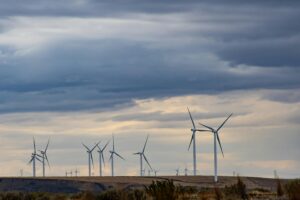Previous experiments on samples of wind turbine blades have provided valuable insights into their composition and pyrolysis process. However, limitations in the availability of samples interfered with the identification of the actual recycling outcome. A need for a real wind turbine blade to continue research was expressed.
In 2023, Dr Yousef and his team continued their experiments. This time – on real wind turbine blade fragments, provided by a Danish company “European Energy A/S”.
“In our new research, experiments were performed on fragments of real wind turbine blades, allowing the yield and composition of final products to be determined,” says Dr Yousef.
The main component is dangerous to health and the environment
The analysis of a several wind turbine blades revealed that unsaturated polyester resins are predominant in the production of wind turbines in the Baltic region due to their cost-effectiveness compared to epoxy resins. Styrene, a main component of polyester resin, poses significant environmental and health risks.
“When disposed of in landfills, it becomes highly toxic for humans and can cause lung cancer. In addition, styrene can pollute and poison groundwater and soil,” explains Dr Yusef.
To address this, the research team made of KTU and Lithuanian Energy Institute scientists successfully extracted styrene from blades in the form of styrene-rich oil using a pyrolysis reactor.
“The main goal of the research was to find a way to extract carbon fibres and resin from old wind turbine blades that are difficult to dispose of because they contain toxic substances and aren’t biodegradable,” says Dr Yousef.
He adds that during the experiments the fibres, carbon and fibreglass were also recovered and purified through an oxidation process, offering a sustainable filler material to enhance the mechanical properties of composite materials.
In addition, the environmental impact of blade treatment using the pyrolysis process was calculated. Conducting the life cycle assessment, Dr Yousef’s team has discovered the significant environmental potential of blade waste pyrolysis compared to landfill disposal. In particular, regarding global warming, stratospheric ozone depletion, and fossil and mineral resource scarcity.
“Results revealed remarkable improvements in various environmental indicators, with enhancements that range between 43–51 per cent. This is a great achievement,” highlights KTU researcher.
However, Dr Yousef emphasises that the strategy still raises certain environmental challenges due to post-treatment processes such as washing and oxidation.
“These issues need to be carefully managed, and only then should future developments take place,” he says.
The article Recovery of energy and carbon fibre from wind turbine blades waste (carbon fibre/unsaturated polyester resin) using pyrolysis process and its life-cycle assessment was published in Environmental Research 2024, volume 245, and can be accessed here.



